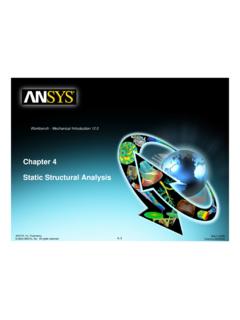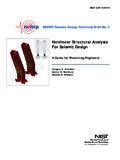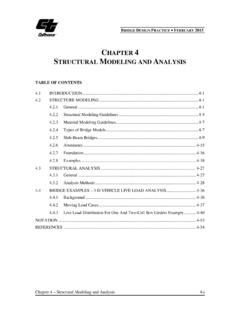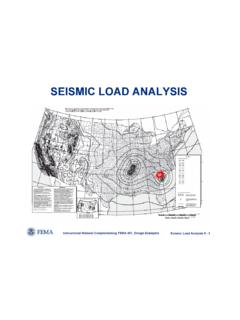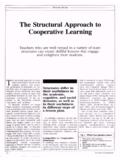Transcription of Patricia H. Thornton and William Ocasio
1 Institutional LogicsPatricia H. Thornton and William OcasioINTRODUCTIONThe phrase, institutional logic has becomesomewhat of a buzz-word. Buzz words areover used; as a result their meanings often getdistorted and overextended and they burn-outof existence. Mizruchi and Fein (1999)showed in the institutional theory literaturehow meanings get distorted and then takenfor granted. To avoid misunderstandings ofthe institutional logic concept and to build onresearch in this genre, now is the time toreflect on definitions and the theoretical andmethodological contributions this perspec-tive brings to the analysis of begin by defining the concept of aninstitutional logic and how it emerged as partof the development of institutional theorysince the 1970s. Second, we illustrate theinstitutional logics approach as both a meta-theory and a method of analysis. Third, wepresent a select review of the literatureemphasizing how the institutional logicsapproach makes headway in addressing sev-eral limitations and tensions identified byscholars of institutional analysis.
2 In thisreview we focus on an analysis of theimplicit and explicit social mechanismsemployed in these studies, not on thedescription or strength of their empiricalfindings. Last, we critique the literature oninstitutional logics and suggest how theapproach can be used to further advance thestudy of organizations and research on institutional logics repre-sents an impressive variety of empirical con-texts, from thrifts (Haveman and Rao, 1997),higher education publishing ( Thornton andOcasio, 1999), health care organizations(Scott et al., 2000), colleges and universities(Gumport, 2000), consumer research(Moorman, 2002), mutual funds (Lounsbury,2002), French cuisine (Rao, Monin, andDurand, 2003), equity markets (Zajac andWestphal, 2004), accounting firms ( Thornton ,Jones, and Kury, 2005), occupational prestigerankings (Zhou, 2005), and architects (Jonesand Livne-Tarandach (Forthcoming), amongothers.)
3 Given the incredible diversity ofresearch topics, what are institutional logics?DEVELOPMENT OF INSTITUTIONALTHEORYTo understand the concept of institutionallogics we must first place it within the con-text of institutional theory and institutionalanalysis. The study of institutions has a long39781412931236-Ch03 1/11/08 5:27 PM Page 99history in organizational analysis, beginningwith Selznick s (1948, 1949, 1957) empiricalanalyses of organizations and the institu-tional environment, and Parson s (1956) theorizing, which emphasized how institu-tions function to integrate organizations withother organizations in society through uni-versalistic rules, contracts, and the 1970s a new approach to institu-tional analysis emerged with Meyer andRowan (1977) and Zucker (1977), who high-lighted the role of culture and cognition ininstitutional analysis. From a macro perspec-tive, Meyer and Rowan (1977) emphasizedthe role of modernization in rationalizingtaken-for-granted rules, leading to isomor-phism in the formal structures of organiza-tions.
4 Organizations had to conform to therequirements of external environments forlegitimacy, meaning that parts of organiza-tions had to be loosely coupled from theirtechnical core. Meyer and his colleagueswere concerned with the importance ofrationality in the account of western culture,and viewed the development of formal orga-nizational structures as part of world societyand its cultural system (Meyer, Boli, andThomas, 1987; Meyer, Boli, Thomas, andRamirez, 1997). From a micro perspective,Zucker (1977) also emphasized the taken-for-granted nature of institutions, and the roleof cultural persistence as a measure of and Powell (1983) extendedMeyer and Rowan s (1977) focus on isomor-phism from the societal level to the level oforganizational fields. With their emphasis oncoercive, normative, and mimetic sources ofisomorphism, DiMaggio and Powell sapproach led to an explosion of empiricalanalysis.
5 In DiMaggio and Powell (1983),the effects of cognition are mainly viewedthrough mimetic isomorphism focusing onmindless behavior in response to culturalrationalization. Subsequently, what theytermed the new institutionalism alsobecame largely identified with a rejection of rationality as an explanation for organiza-tional structure, and an emphasis on legitimacy rather than efficiency as an explanation for the success and survival oforganizations (Tolbert and Zucker, 1983).Friedland and Alford s (1991) seminalessay, together with empirical work byHaveman and Rao (1997), Thornton andOcasio (1999), and Scott et al. (2000), created a new approach to institutional analy-sis which posited institutional logics asdefining the content and meaning of institu-tions. While the institutional logics approachshares with Meyer and Rowan (1977),Zucker (1977), and DiMaggio and Powell(1983, 1991) a concern with how culturalrules and cognitive structures shape organizational structures, it differs from themin significant ways.
6 The focus is no longer onisomorphism, whether in the world system,society, or organizational fields, but on theeffects of differentiated institutional logicson individuals and organizations in a largervariety of contexts, including markets, indus-tries, and populations of organizationalforms. Institutional logics shape rational,mindful behavior, and individual and organi-zational actors have some hand in shapingand changing institutional logics ( Thornton ,2004). By providing a link between institutions and action, the institutionallogics approach provides a bridge betweenthe macro, structural perspectives of Meyerand Rowan (1977) and DiMaggio and Powell(1983) and Zucker s more micro, processapproaches. Situated forms of organizing arelinked with beliefs and practices in widerinstitutional environments in ways thataddress the critique of isomorphism and diffusion studies (Hasselbladh andKallinikos, 2000).
7 DEFINITIONS OF INSTITUTIONALLOGICSWe present definitions of the institutionallogics approach and then return to how it dif-fers from the new institutionalism. The terminstitutional logicswas introduced by Alford100 THE SAGE HANDBOOK OF ORGANIZATIONAL INSTITUTIONALISM9781412931236-Ch03 1/11/08 5:27 PM Page 100and Friedland (1985) to describe the contra-dictory practices and beliefs inherent in theinstitutions of modern western describe capitalism, state bureaucracy,and political democracy as three contendinginstitutional orders which have differentpractices and beliefs that shape how individ-uals engage political and Alford (1991) further devel-oped the concept in the context of exploringthe interrelationships between individuals,organizations, and society. They view institutions as supraorganizational patterns ofactivity rooted in material practices and symbolic systems by which individuals andorganizations produce and reproduce theirmaterial lives and render their experiencesmeaningful.
8 Rejecting both individualistic,rational choice theories and macro structuralperspectives, they posited that each of theinstitutional orders has a central logic thatguides its organizing principles and providessocial actors with vocabularies of motive anda sense of self ( , identity). These practicesand symbols are available to individuals,groups, and organizations to further elabo-rate, manipulate, and use to their own advan-tage (Friedland and Alford, 1991: 232, 248,251 252).For Friedland and Alford (1991) the coreinstitutions of society the capitalist market,the bureaucratic state, families, democracy,and religion each has a central logic thatconstrain both the means and ends of individ-ual behavior and are constitutive of individu-als, organizations, and society. However,while institutions constrain action they alsoprovide sources of agency and change. Thecontradictions inherent in the differentiatedset of institutional logics provide individuals,groups, and organizations with culturalresources for transforming individual identi-ties, organizations, and separate, albeit related, conception ofinstitutional logics was developed by Jackall(1988).
9 In his ethnographic analysis of ethi-cal conflicts in corporations, Jackall (1988:112) defines institutional logic as the complicated, experientially constructed, andthereby contingent set of rules, premiumsand sanctions that men and women in partic-ular contexts create and recreate in such away that their behavior and accompanyingperspective are to some extent regularizedand predictable. Put succinctly, an institu-tional logic is the way a particular socialworld works. Jackall, like Friedland andAlford, views institutional logics as embod-ied in practices, sustained and reproduced bycultural assumptions and political the emphasis for Jackall is on the norma-tive dimensions of institutions and the intra-institutional contradictions of contem-porary forms of organization; in contrast thefocus for Friedland and Alford is on symbolic resources and the inter-institutionalcontradictions of the inter-institutionalsystem, for example between the market andthe family and the professions and the on the developments of the concept by both Jackall (1988) and Friedlandand Alford (1991), Thornton and Ocasio (1999: 804) defined institutional logics as the socially constructed, historical patternsof material practices, assumptions, values,beliefs, and rules by which individuals produce and reproduce their material subsis-tence, organize time and space, and providemeaning to their social reality.
10 According tothis definition institutional logics provide alink between individual agency and cognition and socially constructed institu-tional practices and rule structures. WhileFriedland and Alford s approach is bothstructural and symbolic, and Jackall s is bothstructural and normative, Thornton andOcasio s (1999) approach to institutionallogics integrates the structural, normative,and symbolic as three necessary and comple-mentary dimensions of institutions, ratherthan separable structural (coercive), norma-tive, and symbolic (cognitive) carriers, assuggested by alternative approaches ( , Scott, [1995] 2001).While varying in their emphasis, the vari-ous definitions of institutional logics all presuppose a core meta-theory: to understandINSTITUTIONAL LOGICS1019781412931236-Ch03 1/11/08 5:27 PM Page 101individual and organizational behavior, itmust be located in a social and institutionalcontext, and this institutional context bothregularizes behavior and provides opportu-nity for agency and change.

